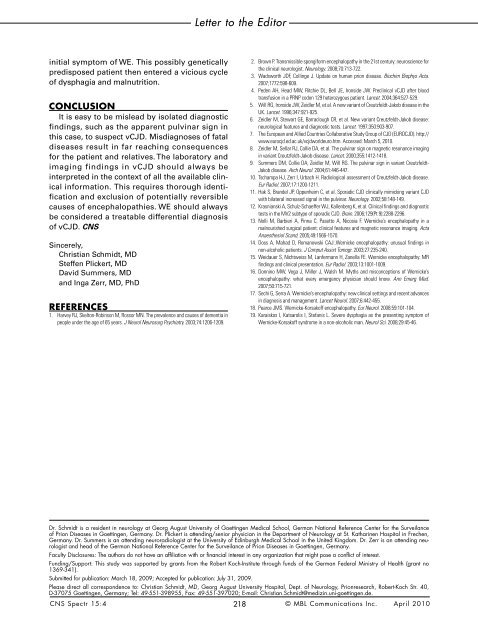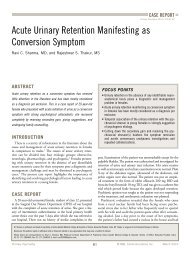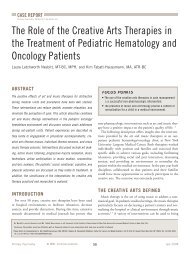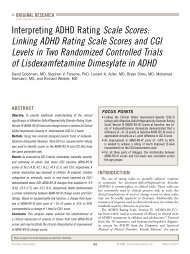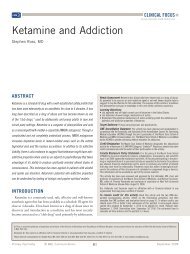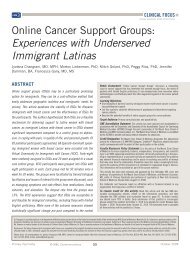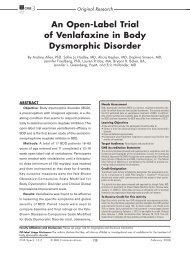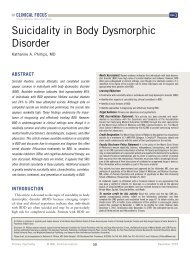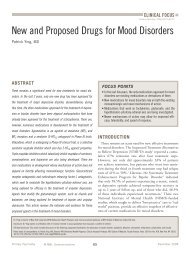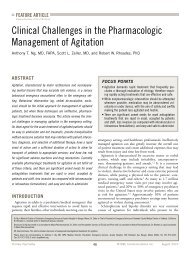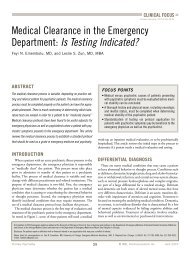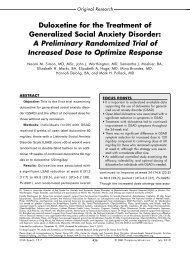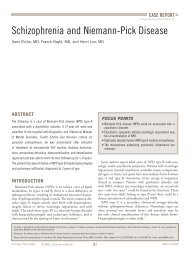Pulvinar Sign in Wernicke's Encephalopathy - MBL Communications
Pulvinar Sign in Wernicke's Encephalopathy - MBL Communications
Pulvinar Sign in Wernicke's Encephalopathy - MBL Communications
Create successful ePaper yourself
Turn your PDF publications into a flip-book with our unique Google optimized e-Paper software.
<strong>in</strong>itial symptom of WE. This possibly genetically<br />
predisposed patient then entered a vicious cycle<br />
of dysphagia and malnutrition.<br />
CONCLUSION<br />
It is easy to be mislead by isolated diagnostic<br />
f<strong>in</strong>d<strong>in</strong>gs, such as the apparent pulv<strong>in</strong>ar sign <strong>in</strong><br />
this case, to suspect vCJD. Misdiagnoses of fatal<br />
diseases result <strong>in</strong> far reach<strong>in</strong>g consequences<br />
for the patient and relatives. The laboratory and<br />
imag<strong>in</strong>g f<strong>in</strong>d<strong>in</strong>gs <strong>in</strong> vCJD should always be<br />
<strong>in</strong>terpreted <strong>in</strong> the context of all the available cl<strong>in</strong>ical<br />
<strong>in</strong>formation. This requires thorough identification<br />
and exclusion of potentially reversible<br />
causes of encephalopathies. WE should always<br />
be considered a treatable differential diagnosis<br />
of vCJD. CNS<br />
S<strong>in</strong>cerely,<br />
Christian Schmidt, MD<br />
Steffen Plickert, MD<br />
David Summers, MD<br />
and Inga Zerr, MD, PhD<br />
REFERENCES<br />
1. Harvey RJ, Skelton-Rob<strong>in</strong>son M, Rossor MN. The prevalence and causes of dementia <strong>in</strong><br />
people under the age of 65 years. J Neurol Neurosurg Psychiatry. 2003;74:1206-1209.<br />
Letter to the Editor<br />
2. Brown P. Transmissible spongiform encephalopathy <strong>in</strong> the 21st century: neuroscience for<br />
the cl<strong>in</strong>ical neurologist. Neurology. 2008;70:713-722.<br />
3. Wadsworth JDF, Coll<strong>in</strong>ge J. Update on human prion disease. Biochim Biophys Acta.<br />
2007;1772:598-609.<br />
4. Peden AH, Head MW, Ritchie DL, Bell JE, Ironside JW. Precl<strong>in</strong>ical vCJD after blood<br />
transfusion <strong>in</strong> a PRNP codon 129 heterozygous patient. Lancet. 2004;364:527-529.<br />
5. Will RG, Ironside JW, Zeidler M, et al. A new variant of Creutzfeldt-Jakob disease <strong>in</strong> the<br />
UK. Lancet. 1996;347:921-925.<br />
6. Zeidler M, Stewart GE, Barraclough CR, et al. New variant Creutzfeldt-Jakob disease:<br />
neurological features and diagnostic tests. Lancet. 1997;350:903-907.<br />
7. The European and Allied Countries Collaborative Study Group of CJD (EUROCJD). http://<br />
www.eurocjd.ed.ac.uk/vcjdworldeuro.htm. Accessed: March 5, 2010.<br />
8. Zeidler M, Sellar RJ, Collie DA, et al. The pulv<strong>in</strong>ar sign on magnetic resonance imag<strong>in</strong>g<br />
<strong>in</strong> variant Creutzfeldt-Jakob disease. Lancet. 2000;355:1412-1418.<br />
9. Summers DM, Collie DA, Zeidler M, Will RG. The pulv<strong>in</strong>ar sign <strong>in</strong> variant Creutzfeldt-<br />
Jakob disease. Arch Neurol. 2004;61:446-447.<br />
10. Tschampa HJ, Zerr I, Urbach H. Radiological assessment of Creutzfeldt-Jakob disease.<br />
Eur Radiol. 2007;17:1200-1211.<br />
11. Hak S, Brandel JP, Oppenheim C, et al. Sporadic CJD cl<strong>in</strong>ically mimick<strong>in</strong>g variant CJD<br />
with bilateral <strong>in</strong>creased signal <strong>in</strong> the pulv<strong>in</strong>ar. Neurology. 2002;58:148-149.<br />
12. Krasnianski A, Schulz-Schaeffer WJ, Kallenberg K, et al. Cl<strong>in</strong>ical f<strong>in</strong>d<strong>in</strong>gs and diagnostic<br />
tests <strong>in</strong> the MV2 subtype of sporadic CJD. Bra<strong>in</strong>. 2006;129(Pt 9):2288-2296.<br />
13. Nolli M, Barbieri A, P<strong>in</strong>na C, Pasetto A, Nicosia F. Wernicke’s encephalopathy <strong>in</strong> a<br />
malnourished surgical patient: cl<strong>in</strong>ical features and magnetic resonance imag<strong>in</strong>g. Acta<br />
Anaesthesiol Scand. 2005;49:1566-1570.<br />
14. Doss A, Mahad D, Romanowski CAJ:.Wernicke encephalopathy: unusual f<strong>in</strong>d<strong>in</strong>gs <strong>in</strong><br />
non-alcoholic patients. J Comput Assist Tomogr. 2003;27:235-240.<br />
15. Weidauer S, Nichtweiss M, Lanfermann H, Zanella FE. Wernicke encephalopathy: MR<br />
f<strong>in</strong>d<strong>in</strong>gs and cl<strong>in</strong>ical presentation. Eur Radiol. 2003;13:1001-1009.<br />
16. Donn<strong>in</strong>o MW, Vega J, Miller J, Walsh M. Myths and misconceptions of Wernicke’s<br />
encephalopathy: what every emergency physician should know. Ann Emerg Med.<br />
2007;50:715-721.<br />
17. Sechi G, Serra A. Wernicke’s encephalopathy: new cl<strong>in</strong>ical sett<strong>in</strong>gs and recent advances<br />
<strong>in</strong> diagnosis and management. Lancet Neurol. 2007;6:442-455.<br />
18. Pearce JMS. Wernicke-Korsakoff encephalopathy. Eur Neurol. 2008;59:101-104.<br />
19. Karaiskos I, Katsarolis I, Stefanis L. Severe dysphagia as the present<strong>in</strong>g symptom of<br />
Wernicke-Korsakoff syndrome <strong>in</strong> a non-alcoholic man. Neurol Sci. 2008;29:45-46.<br />
Dr. Schmidt is a resident <strong>in</strong> neurology at Georg August University of Goett<strong>in</strong>gen Medical School, German National Reference Center for the Surveilance<br />
of Prion Diseases <strong>in</strong> Goett<strong>in</strong>gen, Germany. Dr. Plickert is attend<strong>in</strong>g/senior physician <strong>in</strong> the Department of Neurology at St. Kathar<strong>in</strong>en Hospital <strong>in</strong> Frechen,<br />
Germany. Dr. Summers is an attend<strong>in</strong>g neuroradiologist at the University of Ed<strong>in</strong>burgh Medical School <strong>in</strong> the United K<strong>in</strong>gdom. Dr. Zerr is an attend<strong>in</strong>g neurologist<br />
and head of the German National Reference Center for the Surveilance of Prion Diseases <strong>in</strong> Goett<strong>in</strong>gen, Germany.<br />
Faculty Disclosures: The authors do not have an affiliation with or f<strong>in</strong>ancial <strong>in</strong>terest <strong>in</strong> any organization that might pose a conflict of <strong>in</strong>terest.<br />
Fund<strong>in</strong>g/Support: This study was supported by grants from the Robert Koch-Institute through funds of the German Federal M<strong>in</strong>istry of Health (grant no<br />
1369-341).<br />
Submitted for publication: March 18, 2009; Accepted for publication: July 31, 2009.<br />
Please direct all correspondence to: Christian Schmidt, MD, Georg August University Hospital, Dept. of Neurology, Prionresearch, Robert-Koch Str. 40,<br />
D-37075 Goett<strong>in</strong>gen, Germany; Tel: 49-551-398955, Fax: 49-551-397020; E-mail: Christian.Schmidt@mediz<strong>in</strong>.uni-goett<strong>in</strong>gen.de.<br />
CNS Spectr 15:4 218<br />
© <strong>MBL</strong> <strong>Communications</strong> Inc. April 2010


